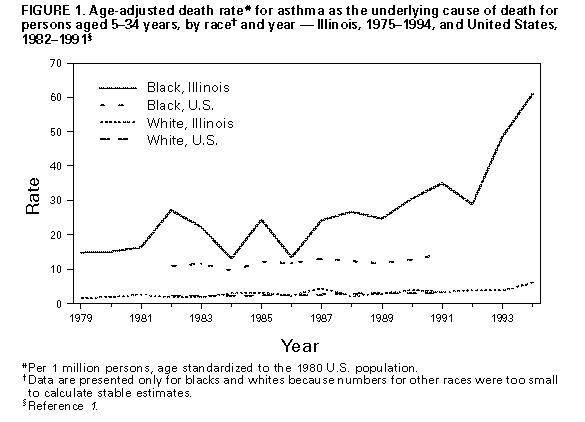 |
|
|
|
|
|
|
| ||||||||||
|
|
|
|
|
|
|
||||
| ||||||||||
|
|
|
|
|
Persons using assistive technology might not be able to fully access information in this file. For assistance, please send e-mail to: mmwrq@cdc.gov. Type 508 Accommodation and the title of the report in the subject line of e-mail. Asthma Mortality -- Illinois, 1979-1994Asthma is a chronic inflammatory disorder of airways characterized by variable airflow obstruction with airway hyperresponsiveness. In the United States, the mortality rate associated with asthma has increased steadily since 1979 (1,2). Uneven distributions of deaths attributable to asthma have been observed among different racial/ ethnic groups (3,4). To examine the distribution of asthma deaths in Illinois, trends in asthma death rates were analyzed for 1979-1994 for Illinois residents. This report presents the findings of this analysis, which indicated that, compared with asthma death rates in the United States for 1982-1991, rates in Illinois were higher and the asthma mortality ratio for blacks to whites was higher. Asthma deaths were abstracted from vital records listing asthma as the underlying cause of death (International Classification of Diseases, Ninth Revision, codes 493.0-493.9). Intercensal population estimates for Illinois were obtained from the U.S. Bureau of the Census. Because of the high accuracy of diagnosing asthma in persons aged less than 35 years (greater than 95%) (5), this analysis presents age-adjusted death rates for persons aged 5-34 years. Calculations of race-specific rates were limited to blacks and whites because numbers for other races were too small to enable estimation of stable rates. During 1979-1994, the annual age-adjusted asthma death rate for persons aged 5-34 years in Illinois increased by 341%, from 3 per million to 15 per million. From 1982 to 1991, the increase was 57%, higher than the national average of 42% for the same period (1). Except in 1986, the annual death rate was consistently higher in Illinois than in the United States by an average of 56%. Annual rates and increases were similar for males and females during 1979-1994 in Illinois. The death rates for asthma were higher among blacks than whites. The asthma death rate for whites in Illinois was indistinguishable from that for whites nationally; however, the death rate for blacks in Illinois was twice as high as the national rate for blacks for most years from 1982 through 1991 (Figure_1). This resulted in a greater black-to-white asthma mortality ratio in Illinois (9) than nationally (less than 5). This ratio increased to 10 in 1994 in Illinois. Reported by: HL Howe, PhD, L Landrum, MS, JR Lumpkin, MD, Illinois Dept of Public Health. Div of Applied Public Health Training (proposed), Epidemiology Program Office, CDC. Editorial NoteEditorial Note: An estimated 14 million persons in the United States are affected by asthma (6), and each year, 4000-5500 deaths are caused by asthma. In addition, morbidity and mortality from asthma have continuously increased and have had a disproportional impact on some population subgroups (7). Although acute episodes of asthma can be fatal, most deaths from asthma are preventable with appropriate medical management (7). Changes in both prevalence and severity of asthma could affect mortality. The prevalence of asthma has increased in the United States (8) with increased recognition and diagnosis of asthma by physicians; increased exposure to environmental allergens and irritants; and increased exposure of children to maternal smoking, household crowding, and poverty (1,2,8). Factors associated with the increased risk for death from asthma include excessive exposure to allergens and air pollution; underestimation of the severity of asthma; psychosocial instability; overuse of inhaled, short-acting b-agonists; underuse of corticosteroids; substance abuse; and inadequate access to appropriate health care (1-3,7). The higher overall rate of asthma mortality and the wider gap between the rates for blacks and whites in Illinois than in the United States primarily were because of the high death rate for blacks rather than a lower death rate for whites. Additional study is needed to determine reasons for the race-specific differences in the rates. Previous studies comparing mortality from asthma between blacks and whites indicate that asthma mortality, regardless of race, is inversely correlated with income (4,9,10). This disparity in asthma mortality between blacks and whites is associated with the generally lower socioeconomic status (SES) for blacks and possibly attributable to greater exposure to allergens and pollutants and poor access to and use of appropriate health care among persons of lower SES (7). State and territorial public health agencies have a critical role in the surveillance and prevention of asthma morbidity and mortality. Most states do not have asthma surveillance and prevention programs (6). CDC encourages states to actively use existing asthma-related data to assess the local burden of asthma and to use that information to target asthma-control and asthma-prevention programs to at-risk populations (6,8). References
Figure_1  Return to top. Disclaimer All MMWR HTML versions of articles are electronic conversions from ASCII text into HTML. This conversion may have resulted in character translation or format errors in the HTML version. Users should not rely on this HTML document, but are referred to the electronic PDF version and/or the original MMWR paper copy for the official text, figures, and tables. An original paper copy of this issue can be obtained from the Superintendent of Documents, U.S. Government Printing Office (GPO), Washington, DC 20402-9371; telephone: (202) 512-1800. Contact GPO for current prices. **Questions or messages regarding errors in formatting should be addressed to mmwrq@cdc.gov.Page converted: 09/19/98 |
|||||||||
This page last reviewed 5/2/01
|